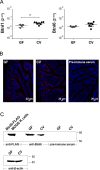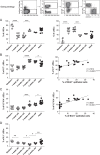The ontogeny of Butyrophilin-like (Btnl) 1 and Btnl6 in murine small intestine
- PMID: 27528202
- PMCID: PMC4985744
- DOI: 10.1038/srep31524
The ontogeny of Butyrophilin-like (Btnl) 1 and Btnl6 in murine small intestine
Abstract
Murine Butyrophilin-like (Btnl) 1 and Btnl6 are primarily restricted to intestinal epithelium where they regulate the function of intraepithelial T lymphocytes. We recently demonstrated that Btnl1 and Btnl6 can form an intra-family heterocomplex and that the Btnl1-Btnl6 complex selectively expands Vγ7Vδ4 TCR IELs. To define the regulation of Btnl expression in the small intestine during ontogeny we examined the presence of Btnl1 and Btnl6 in the small bowel of newborn to 4-week-old mice. Although RNA expression of Btnl1 and Btnl6 was detected in the small intestine at day 0, Btnl1 and Btnl6 protein expression was substantially delayed and was not detectable in the intestinal epithelium until the mice reached 2-3 weeks of age. The markedly elevated Btnl protein level at week 3 coincided with a significant increase of γδ TCR IELs, particularly those bearing the Vγ7Vδ4 receptor. This was not dependent on gut microbial colonization as mice housed in germ-free conditions had normal Btnl protein levels. Taken together, our data show that the expression of Btnl1 and Btnl6 is delayed in the murine neonatal gut and that the appearance of the Btnl1 and Btnl6 proteins in the intestinal mucosa associates with the expansion of Vγ7Vδ4 TCR IELs.
Figures



References
-
- Arnett H. A. et al.. BTNL2, a butyrophilin/B7-like molecule, is a negative costimulatory molecule modulated in intestinal inflammation. J Immunol. 178, 1523–1533, 178/3/1523 (2007). - PubMed
Publication types
MeSH terms
Substances
LinkOut - more resources
Full Text Sources
Other Literature Sources
Molecular Biology Databases

